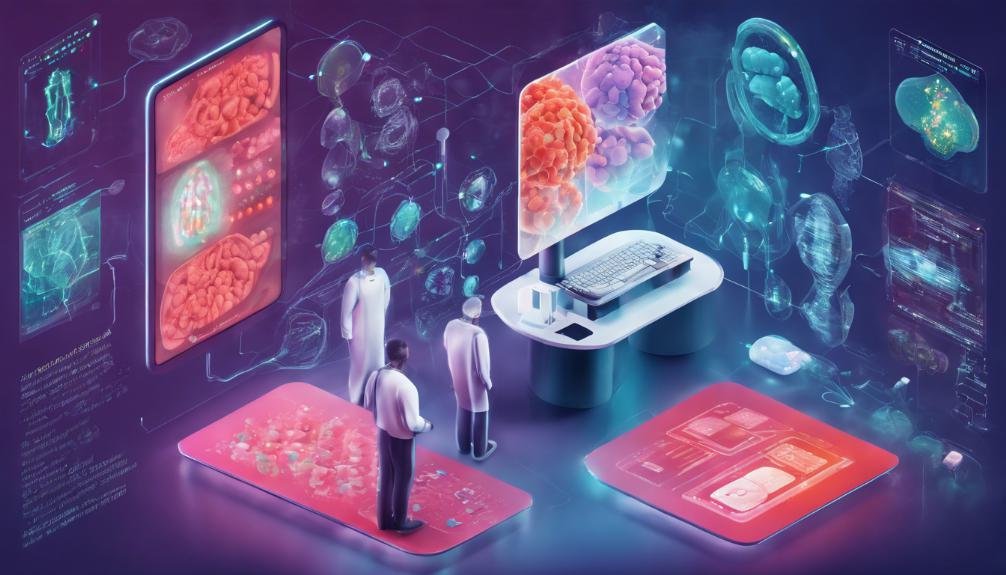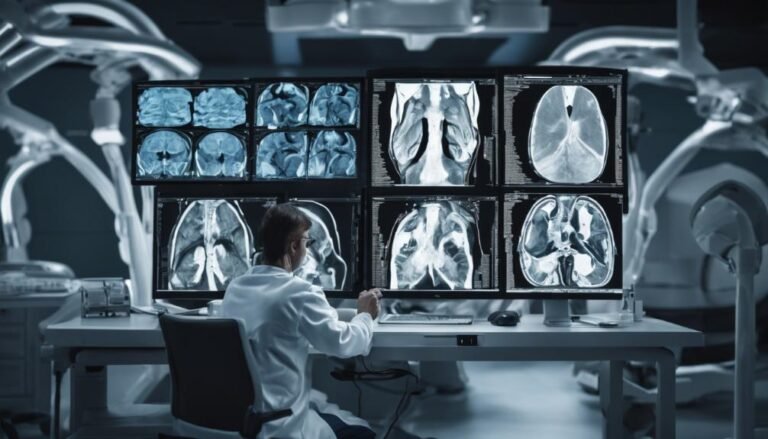AI in Pharmacovigilance
In the domain of pharmacovigilance, the integration of AI technologies has revolutionized the landscape of drug safety surveillance. Imagine a world where algorithms meticulously sift through vast pools of data to pinpoint potential adverse reactions swiftly and accurately. This advancement not only streamlines the detection process but also holds the promise of preemptive risk mitigation strategies. As AI continues to evolve, its potential implications on patient care and regulatory compliance are profound.
Key Takeaways
- AI enhances adverse event detection efficiency and accuracy.
- Machine learning rapidly analyzes large datasets for patterns.
- Real-time monitoring for early safety concern identification.
- Natural language processing extracts data from unstructured sources.
- AI improves patient safety and regulatory compliance in pharmacovigilance.
Applications of AI in Pharmacovigilance
One of the key applications of AI in pharmacovigilance is the automated detection of adverse drug reactions from large volumes of data. Through the use of machine learning algorithms, AI systems can analyze vast datasets to identify patterns and signals that may indicate potential adverse events associated with specific medications. Signal detection is important in pharmacovigilance as it allows for the early identification of potential safety concerns, enabling timely intervention to protect patient health.
Natural language processing (NLP) plays an important role in this process by enabling AI systems to extract relevant information from unstructured sources such as medical reports, social media posts, and electronic health records. By analyzing text data, NLP algorithms can identify mentions of adverse events and categorize them based on severity, frequency, and other factors.
This capability enhances the efficiency and accuracy of adverse event detection, ultimately improving patient safety and regulatory compliance in the pharmaceutical industry.
Benefits of AI Technologies
Utilizing AI technologies in pharmacovigilance offers numerous advantages in enhancing the efficiency and accuracy of adverse event detection processes. AI contributes to efficiency improvement by automating repetitive tasks, allowing for the rapid analysis of large volumes of data.
Through sophisticated algorithms, AI can swiftly sift through vast datasets, identifying patterns and signals that might go unnoticed through manual review. This data analysis capability not only speeds up the detection of adverse events but also enhances the accuracy of the process by reducing the potential for human error.
Furthermore, AI technologies can assist in real-time monitoring of drug safety profiles, enabling healthcare professionals to promptly respond to emerging safety concerns. By continuously analyzing data streams, AI systems can provide early warnings of potential adverse reactions, facilitating proactive risk management strategies.
Challenges in Implementing AI
Implementing AI in pharmacovigilance poses several significant challenges that need to be addressed to fully leverage the potential benefits of artificial intelligence technologies. One key challenge is ensuring data accuracy, as the effectiveness of AI algorithms heavily relies on the quality of the input data. Inaccurate or incomplete data can lead to erroneous conclusions and recommendations, impacting patient safety and decision-making processes.
Ethical considerations also play an important role in the implementation of AI in pharmacovigilance. Issues such as patient privacy, consent, and transparency in algorithmic decision-making need to be carefully navigated to maintain trust and uphold ethical standards.
Additionally, implementation hurdles like integrating AI systems with existing pharmacovigilance processes, ensuring regulatory compliance, and managing the shift from traditional methods to AI-driven approaches can be complex and time-consuming.
Overcoming these challenges is essential to harnessing the full potential of AI in enhancing drug safety monitoring and surveillance practices.
Future Trends in Drug Safety
As the landscape of pharmacovigilance continues to evolve rapidly, future trends in drug safety are poised to revolutionize the way adverse events are monitored and managed in the pharmaceutical industry.
Predictive analytics and machine learning are at the forefront of these advancements, offering the potential to enhance signal detection and improve the identification of adverse events associated with medications.
With predictive analytics, pharmaceutical companies can proactively identify potential safety issues by analyzing vast amounts of data to predict adverse events before they occur.
Machine learning algorithms can sift through complex datasets to uncover patterns and correlations that may go unnoticed by traditional methods, enabling more efficient monitoring and mitigation of risks.
Regulatory Impact of AI
The integration of artificial intelligence (AI) into pharmacovigilance practices is reshaping regulatory processes and oversight within the pharmaceutical industry. AI technologies offer significant advancements in data processing and analysis, enabling more efficient detection of adverse drug reactions. However, this transformation raises important regulatory considerations.
Data privacy and transparency are vital aspects impacted by the use of AI in pharmacovigilance. Ensuring that patient data is securely handled and that the algorithms' decision-making processes are transparent to regulatory bodies is essential for maintaining trust and compliance.
Ethical considerations and accountability also come to the forefront with AI implementation in pharmacovigilance. The responsibility for the outcomes of AI-driven decisions falls on both the developers and the pharmaceutical companies utilizing these technologies.
It's imperative to establish clear guidelines and mechanisms for ethical AI use to safeguard patient safety and uphold regulatory standards in drug safety monitoring.
Conclusion
To sum up, AI in pharmacovigilance is revolutionizing drug safety monitoring by streamlining adverse event detection and analysis.
The benefits of AI technologies are evident in their ability to process vast amounts of data quickly and efficiently.
However, challenges in implementation and regulatory hurdles remain.
Despite these obstacles, the future of drug safety looks promising with the continued advancements in AI.
So, sit back, relax, and let the robots do the heavy lifting in keeping us all safe and sound.







